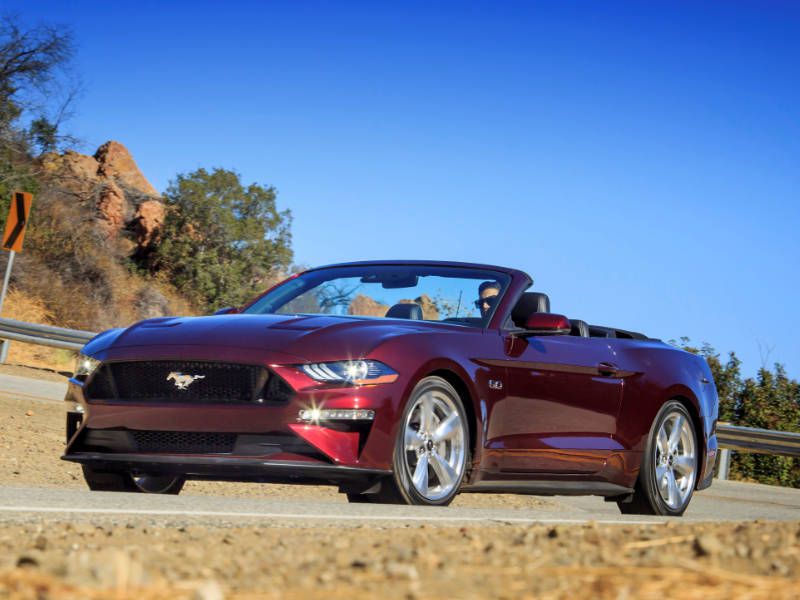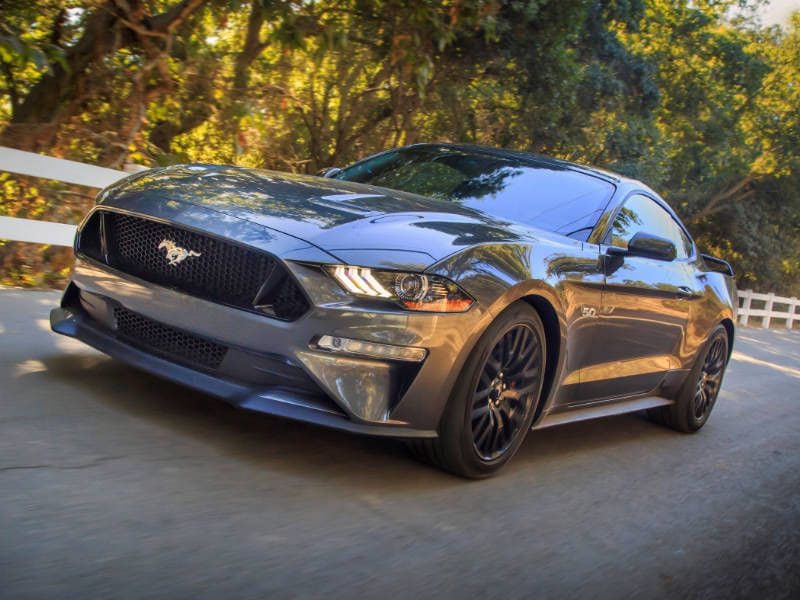Recent Articles
Popular Makes
Body Types
2019 Kia Stinger vs. 2019 Ford Mustang: Which is Best?

2018 Kia Stinger ・ Photo by Kia
Pitting one of the most celebrated sport coupes against the latest sport sedan may not seem like an obvious matchup at first glance. But dig deeper, and you’ll see that the 2019 Kia Stinger and 2019 Ford Mustang both are directed at the same target: Drivers of any age who want a stylish, affordable performance vehicle.
Mustang now is in its sixth generation of production, which debuted to coincide with the coupe’s fiftieth anniversary in 2015. Following a facelift in 2018, Mustang returns essentially unchanged for 2019, with a couple of special edition models joining the lineup for the model year.
Stinger debuted as a 2018 model, boasting the highest performance of any production Kia model to date. It returns for 2019 with a few tweaks to trim levels and equipment.
Let’s explore the details of each vehicle to discover which is best, the 2019 Kia Stinger or 2019 Ford Mustang.
Design
Mustang took a big step into the past with its fifth-generation design (2005 – 2014). Lead designer J Mays employed an aesthetic that he called “retrofuturism,” a design technique that captured echoes and flavors of older Mustang designs and brought them into the present. The current Mustang continues that trend, relying heavily on the pony car heritage to evoke an aura of cool. The special edition Bullitt Mustang is the most fully realized example of this trend. Mustang is available as a fixed-roof fastback coupe or as a convertible.
Kia designers, under the leadership of Peter Schreyer, didn’t have heritage to rely upon when they dreamed up the Stinger. They started with an elegant front axle to dash distance, and then employed a fastback-style roof to camouflage Stinger’s rear doors with a coupe-like profile. Stinger’s cargo compartment is accessed via a large hatch, a practical design element that blends well with the overall vehicle shape.
Advantage: Mustang

Photo by Ford
Engine
Stinger is available with a choice of two turbocharged gasoline engines: a 2.0-liter inline four-cylinder that puts out 255 hp and 260 lb-ft of torque, and a 3.3-liter V6 with twin turbos and output rated at 365 hp and 376 lb-ft of torque.
Mustang is available with either a 2.3-liter EcoBoost turbocharged inline four-cylinder gasoline engine (producing 310 hp and 350 lb-ft of torque), or a 5.0-liter naturally aspirated (non-turbo) V8 (producing 460 hp and 420 lb-ft of torque). Additionally, the Bullitt Mustang gets special tuning that boosts its 5.0-liter V8 up to 480 hp.
There’s more to an engine than displacement and output. Stinger’s engines have aluminum blocks and aluminum heads, and each has double overhead cams, four valves per cylinder, variable valve timing, and gasoline direct injection. Mustang’s 5.0 uses both gasoline direct injection and port injection to achieve its big power ratings.
Advantage: Mustang

Photo by Ford
Transmission/Drivetrain
Kia has equipped the Stinger with a conventional eight-speed automatic transmission, while Ford gives its buyers the option of a manual six-speed transmission with rev-matching (rev-matching on the V8 only), or a 10-speed SelectShift automatic with paddle shifters.
Mustang is rear-wheel drive only, while Stinger comes with standard rear-wheel drive or available all-wheel drive. Enthusiast drivers definitely tend to prefer rear-wheel drive over front-wheel drive, but tastes vary when it comes to all-wheel drive. Drivers who live in colder or rainier climates consider all-wheel drive essential for year-round use and enhanced safety, while those who live in convertible country love the predictable drift that rear-wheel drive can deliver.
Advantage: Mustang

Photo by Ford
Comfort/Amenities
As a coupe, Mustang concentrates its comfort and amenities on the driver and front-seat passenger. The second row is an occasional-use perch with just 29.0 inches of legroom and 34.8 inches of headroom, more suitable for a briefcase than an adult. Total passenger volume is 82.8 cubic feet in the fastback, and 79.2 cubic feet in the convertible. Mustang can carry 13.5 cubic feet of luggage in the fastback trunk, and 11.4 cubic feet in the convertible trunk. That said, the front sport bucket seats are very comfortable and supportive, with a healthy amount of bolstering to keep side-to-side movement to a minimum.
Stinger has four doors, and 36.4 inches of legroom with 37.0 inches of headroom for second-row passengers. Total passenger volume is 93.8 cubic feet, and cargo volume is 23.3 cubic feet. Stinger’s seats are equally comfortable and supportive as Mustang’s, and also are well-bolstered in the style of sport seats.
Advantage: Stinger

Photo by Kia
Suspension/Steering/Brakes
Mustang took an enormous leap forward when it went to a fully independent suspension in 2015, finally abandoning the solid rear axle that it had in its first five generations. An available MagneRide adaptive suspension system can improve handling even further. Selectable-effort electronic power-assisted steering delivers great feel, and can be adjusted to the driver’s preferences. Four-wheel disc brakes with ABS haul Mustang down from speed with great predictability and little fade on the street.
Stinger uses a four-wheel independent suspension, too, with MacPherson struts up front and a five-link rear. Electric rack-and-pinion power steering comes with constant effort in four-cylinder models, and variable effort in the V6. Four-wheel disc brakes with ABS are standard, with vented front discs in the four-cylinder models and vented discs all around on the V6.
Advantage: Mustang

Photo by Ford
Infotainment/Technology
Stinger comes with a substantial pack of standard technology, with even more available. The base setup is a 7-inch touchscreen audio system with six speakers, Bluetooth hands-free and audio streaming, Apple CarPlay, Android Auto and UVO eServices Telematics. The next step up is an 8-inch touchscreen with navigation, nine speakers and an external amp; and finally a Harmon Kardon 720-watt surround sound system with 15 speakers.
Mustang starts out similarly, with SYNC and a 4.2-inch color LCD screen along with a six-speaker AM/FM stereo speaker system. Premium models get SYNC 3 with an eight-inch color capacitive touchscreen and two smart-charging USB ports. The top-of-the-line available audio upgrade is a 1,000-watt B&O Play system with Apple CarPlay for Ford+Alexa and Waze.
Advantage: Stinger

Photo by Kia
Safety
The fastback version of Mustang is equipped with driver’s knee, glove-box-door-integrated knee, front-seat side, and side-curtain airbags. The convertible doesn’t get side-curtain airbags, for obvious reasons. Electronic stability control is standard, along with TPMS, LATCH in rear outboard seats, rear-view camera, SOS Post-Crash Alert System, and more. A reverse-sensing system, adaptive cruise, forward collision warning, and pre-collision assist with pedestrian detection all are available.
Stinger gets the full array of airbags (dual front, dual front seat-mounted, full-length side curtain, and driver’s knee), along with ESC, ABS, brake fade compensation, hill-start assist, traction control, LATCH, TPMS, parking distance warning (front and reverse), blind spot collision warning system with lane change assist, rear cross-traffic collision warning, and rear view camera all are standard. Forward collision avoidance assist, lane keep assist, lane departure warning, driver attention warning, high beam assist, and Smart Cruise Control come with higher trim levels.
Advantage: Stinger

Photo by Kia
Driving Experience
Mustang and Stinger offer markedly different driving experiences. Mustang belongs in the ranks of muscle cars, while Stinger wants to be measured against European sport sedans. In a straight line, you want to be in a Mustang – especially if you appreciate the grunt of a big American V8 engine like you’ll find in the GT trim level. The Mustang fastback weighs between 3,542 and 3,765 lbs (add about 200 lbs for the convertible), while Stinger curb weight is between 3,611 and 4,023 lbs. Stinger feels lighter on its feet, and has a more precise steering feel than Mustang.
Ultimately, both vehicles are fun to drive, each with a different approach. Some drivers may prefer Mustang with the Performance Package, MagneRide Suspension and a manual transmission; drivers who seek more finesse will feel more at home in the Stinger with a V6 and all-wheel drive.
Advantage: Mustang

Photo by Ford
Pricing
Stinger prices start at $32,900 for the base 2.0 RWD. Premium 2.0 RWD starts at $39,100. GT V6 RWD starts at $39,100; GT1 starts at $45,100; and GT2 starts at $49,990. Add $2,200 for AWD on any trim level.
Mustang convertible is available in three trim levels: EcoBoost ($31,620); EcoBoost Premium ($36,635); and GT Premium ($44,855). Mustang fastback prices start at $26,120 for the EcoBoost; $31,135 for the EcoBoost Premium. GT (V8) starts at $35,355; GT Premium starts at $39,355; and Bullitt starts at $46,595. You can add MagneRide for $1,695, and Recaro seats for $1,595. The GT Performance Package adds $3,995, and the Performance Package Level 2 adds $6,500. Mustang has a lot more a la carte options available than Stinger.
Advantage: Mustang

Photo by Ford
Recommendations
This is one of those comparisons that is very difficult to call. The 2019 Kia Stinger and 2019 Ford Mustang are so different that the decision between them will be a matter of taste and personal style.
Despite the fact that it has plenty of modern technology aboard, Mustang is a throwback vehicle. That’s intentional, and it’s effective. The current Mustang is the best of any generation, and measures up well to its prime competitors – the Dodge Challenger and Chevrolet Camaro.
Stinger is in its second year, and has different targets. Kia wants you to measure it against the BMW 3 Series, Lexus IS, Mercedes-Benz C-Class, and other premium sport sedans. On that basis, it does pretty well, and is deserving of serious consideration.
The opening question was “2019 Kia Stinger vs. 2019 Ford Mustang: Which is Best?” If this is the choice, the answer is…2019 Ford Mustang.

Photo by Ford